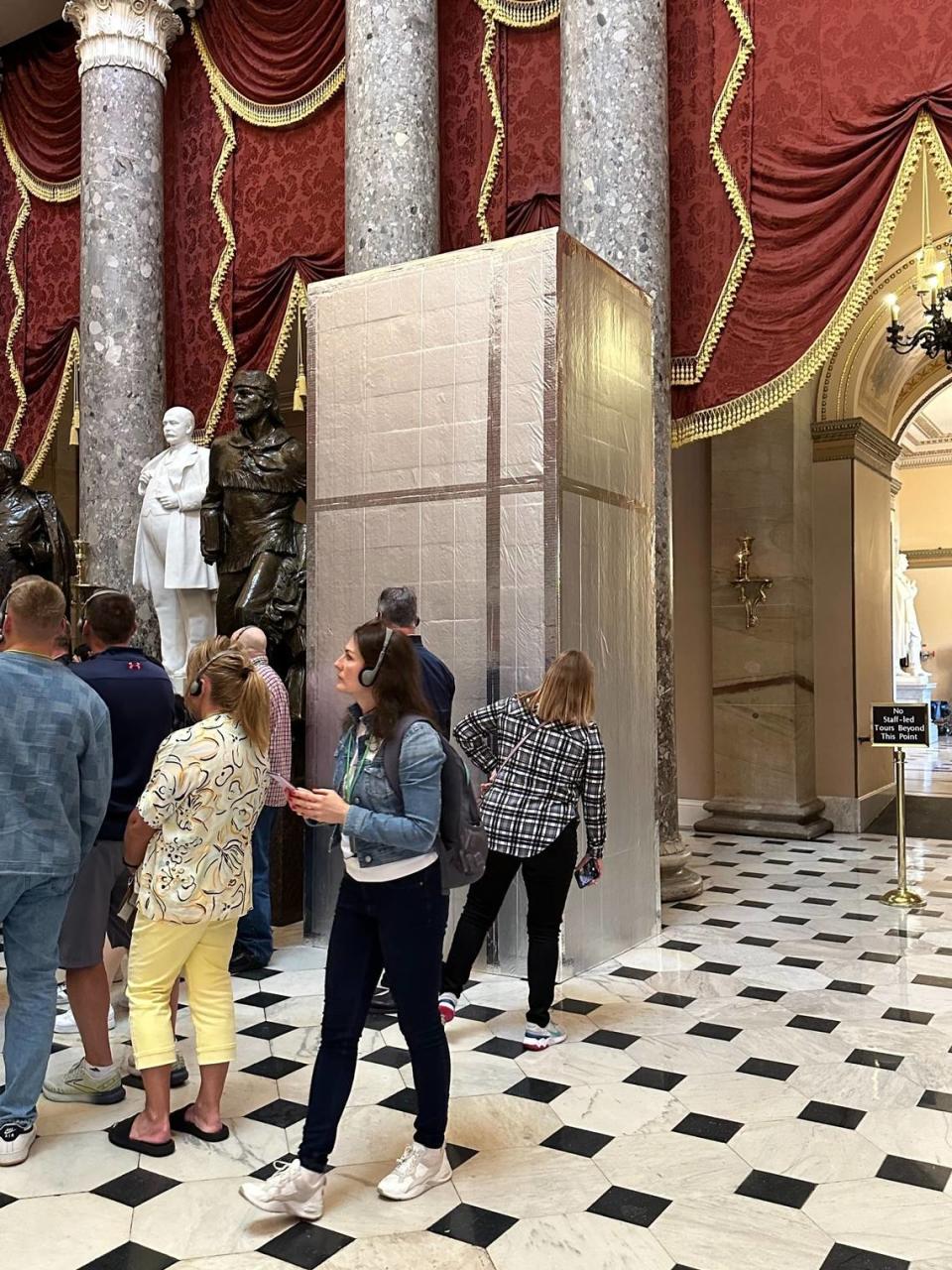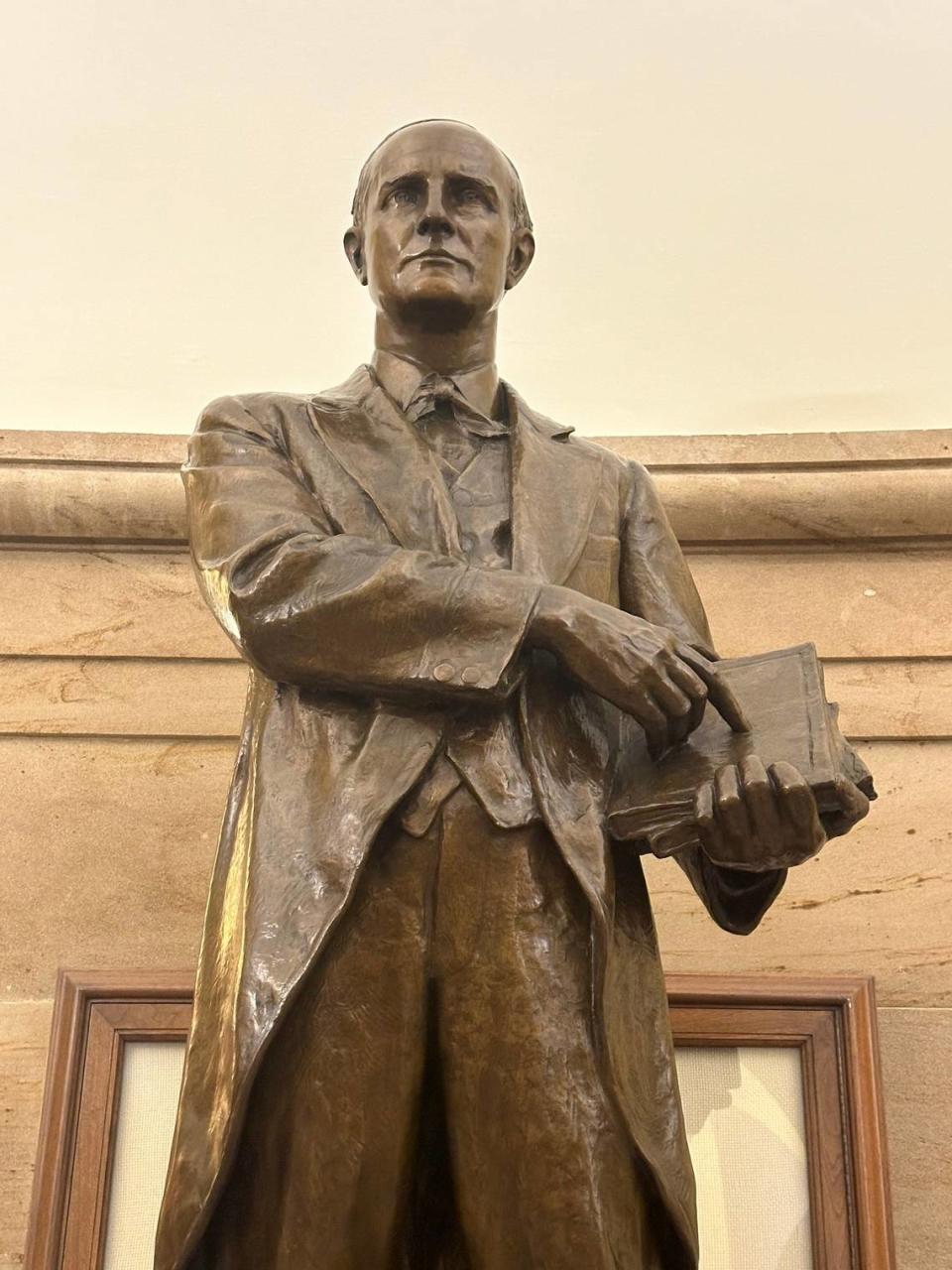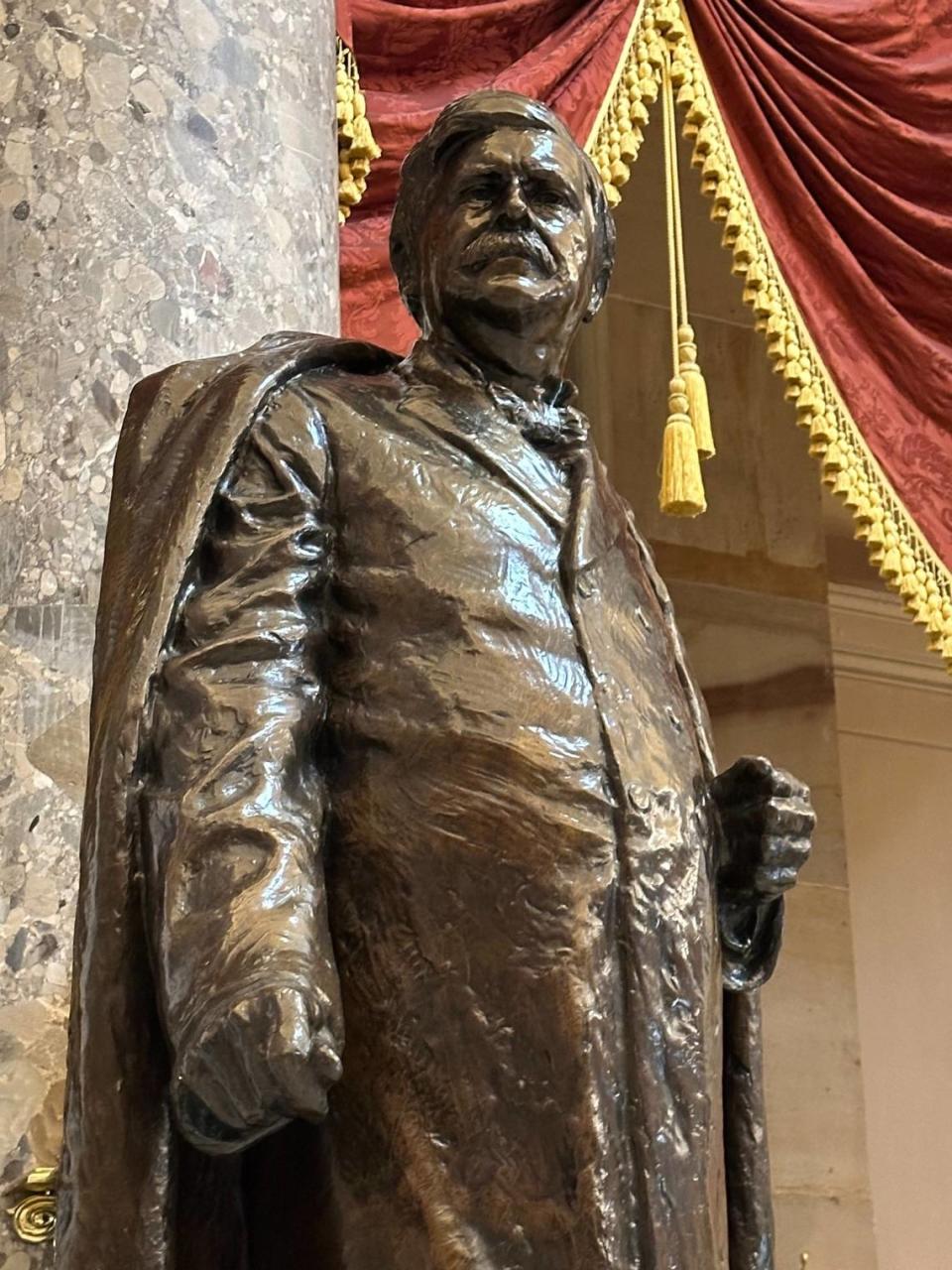Rev. Billy Graham statue to be unveiled in US Capitol, replacing white supremacist
- Oops!Something went wrong.Please try again later.
- Oops!Something went wrong.Please try again later.
- Oops!Something went wrong.Please try again later.
North Carolina lawmakers spent nearly a decade working to have the Rev. Billy Graham to be memorialized in the U.S. Capitol.
On Thursday, a statue of Graham — who died in 2018 at age 99 — will be unveiled as part of the Capitol’s National Statuary Hall Collection.
This makes Graham one of the few private citizens to hold three of the highest honors from Congress: a Congressional Gold Medal, to have laid in honor at the Capitol and to have a statue commissioned for the Statuary Hall collection.
“This is a great honor and my father would be humbled and grateful,” said Franklin Graham, president and CEO of the Billy Graham Evangelistic Association and Samaritan’s Purse, in a news release. “At the same time, he would not want the attention on himself but on God’s Son, the Lord Jesus Christ.”
Replacing Aycock
Every state is afforded the opportunity to honor two notable, deceased people from that state, in the U.S. Capitol as part of the Statuary Hall Collection. The statues are kept in five locations around the Capitol: Statuary Hall, the Rotunda, the Crypt, the Hall of Columns and the Capitol Visitor Center.

The men and women honored range from former President George Washington to everyone’s favorite neighbor, Mister Rogers. From celebrities to explorers, from civil rights leaders to presidents, they’re each a part of the collection.
North Carolina commissioned statues of two former governors: Charles Aycock and Zebulon Vance.
But after reading ”The Paradox of Tar Heel Politics” by former N&O columnist Rob Christensen, Rep. Patrick McHenry, a Republican from Lincoln County, said he knew one of those men needed to go.
“(The book) goes into the details of really an era of deeply sordid politics — just some of the worst, most despicable acts of humanity in the Reconstruction era,” McHenry said. “And then it goes into the 1898 Red Shirt campaign and the threats of violence. And the mastermind of that was Aycock.”

Aycock, a Democrat, served as North Carolina’s 50th governor beginning in 1901. But he rose to power stifling the Black vote, and his constant cries for white supremacy are blamed in official reports for causing the Wilmington Massacre, an insurrection that killed dozens of Black people and overthrew the Wilmington government, which included both Black and white members.
The News & Observer’s former editor Josephus Daniels also played a large role in the Wilmington Massacre, and he and Aycock met to plan how he could help advance Aycock’s agenda.
“Why does he deserve a statue in the U.S. Capitol?” McHenry asked.
Who gets a statue?
McHenry said he started thinking about who would be better as a North Carolinian.
He ended up in a discussion, around 2012, with two then-staffers of Majority Leader Eric Cantor — Kyle Nevins, of Chapel Hill, and Neil Bradley — about who should replace Aycock. Both said Graham.
Graham was a Baptist minister and an internationally known evangelist. He counseled foreign leaders and 12 sitting presidents, beginning with Harry Truman. Graham is said to have preached to around 215 million people worldwide.
Montreat, Graham’s home, falls in McHenry’s district. He decided to make calls to the state legislature to get the ball rolling on Graham as Aycock’s replacement, a switch that could only be made once Graham died.
In 2013, North Carolina legislators named Graham the state’s “Favorite Son” in a unanimous vote.
In 2015, former Gov. Pat McCrory signed into law a bill that said a statue of Graham should be commissioned to represent North Carolina in the Capitol, saying “There have been many great North Carolinians but few have impacted the world more than Billy Graham.”
Backlash to choice of Graham
Graham has not been immune to controversy.
In 2002 and 2009, recordings of Graham and former President Richard Nixon were released. In the audio, Graham can be heard saying that Jews control American media and that Nixon could change that if he were reelected. The second recording took aim at Jewish reporters.
In 2002, Graham apologized for the comments, saying they don’t reflect his views and he deeply regretted making the comments. Graham was a longtime supporter of Israel. In 2009, a Graham spokesperson said in the second recording that Graham was speaking about reporters pretending to be Jews.
His views on feminism and homosexuality have also caused consternation.
But it was actually Graham’s faith that led several readers to email McClatchy, worried that choosing Graham for the statue alienated North Carolinians who practiced other religions.
According to Pew Research Center, 77% of North Carolinians identify as Christians, 3% identify as other faiths, 5% identify either as atheist or agnostic, 15% said they don’t identify as any religion in particular.
“Yes, Billy Graham is an evangelist,” McHenry said, “but he is the best known North Carolinian in the history of the state. He didn’t identify with any party or partisanship and I would point you to his words that his pursuit was to carry the word of Christ and to expose Christ to the world.
“And I think the way he lived was the finest example of ethics and morality, whether you’re a Christian or not,” McHenry added.
Graham stayed politically neutral when he spoke, but he was a registered Democrat. He has been credited with helping the cause of civil rights.
McHenry added that Graham’s fairness, love and kindness transcends “the mere question of faith.”
Replacing Vance?
Being one of the original 13 colonies, North Carolina gets the honor of having one of its statues located in the Capitol’s crypt. Currently, that’s Aycock. No, bodies are not buried in the Crypt, but Congress hoped to make it the final resting place of Washington. He chose instead to be buried at his home, Mount Vernon, in Alexandria, Virginia.
McHenry said Aycock’s statue will be returned to North Carolina, where lawmakers will decide its future.
Statues of both Aycock and Vance already stand across from one another in Raleigh’s Union Square, on the state Capitol grounds.
Vance was a popular Democrat, who owned slaves, defended North Carolina as a member of the Confederacy in the Civil War, supported white supremacy and used racism as a regular part of his speech.

After the death of George Floyd, a Black man killed by a white police officer in Minnesota, there was a push around the state and throughout the country to take down statues that honored racist figures, including Vance.
And while that worked in Asheville, he remains in the U.S. Capitol with no current plans to replace him.
“I don’t see anybody in our current history that exceeds his leadership,” McHenry said. “He was in the Senate for 30 years. His story is less sordid and not perfect, but less sorted sordid than that of Aycock, in my view.”
Thursday’s ceremony
McHenry, along with Sens. Thom Tillis and Ted Budd, worked to expedite the process of getting Graham placed in the Capitol after hitting several delays.
“Through his lifetime of faithfully preaching the Gospel, Rev. Billy Graham changed the world,” Budd told McClatchy, in a written statement. “It has been my honor to help remember the legacy of this historic North Carolinian in the U.S. Capitol forever.”
Tillis agreed, in a written statement calling Graham “America’s pastor” who dedicated his life to preaching the Gospel and who inspired millions of people around the world.
“He was a proud North Carolinian whose service bettered our country and the world, and I’m proud to have worked with the North Carolina delegation to ensure his legacy will represent our great state as one of two statues representing North Carolina in the U.S. Capitol,” Tillis said.
The unveiling will happen during a private ceremony attended by Graham’s family, House Speaker Mike Johnson and members of Congress. Three-time Grammy winner Michael W. Smith is set to perform.
McHenry said he is bringing Nevins, Bradley and his former chief of staff, Parker Poling, as his guests.
Charlotte artist Chas Fagan created the 7-foot statue of Graham that shows him gesturing toward an open Bible. Inscribed on the pedestal will be two Bible verses: John 3:16 and John 14:6, both offering central Christian beliefs on being saved.
Fagan, who is self-taught, also designed the statue of former President Ronald Reagan in the Rotunda.
Carolina Bronze Sculpture, a foundry located in Seagrove, cast the statue in bronze, and a quarry in Rowan County provided the Salisbury granite for the base.

